Please see below Case Study MCQ Questions Chapter 12 Electricity Class 10 Science. These MCQ Questions with Answers for Case study have been designed as per the latest syllabus and examination guidelines of Class 10 Science. Cased Study Based MCQ Questions for Class 10 Science are expected to come in the upcoming exams. We have provided a lot of case studies for all chapters in standard 10 science. Please solve the MCQ Questions and compare with the answers provided by our teachers.
Chapter 12 Electricity Class 10 Science Case Study MCQ Questions
Two tungston lamps with resistances R1 and R2 respectively at full incandescence are connected first in parallel and then in series, in a lighting circuit of negaligible internal resistance. It is given that: R1 > R2.
Question. Which lamp will glow more brightly when they are connected in series?
(a) Bulb having lower resistance
(b) Bulb having higher resistance
(c) Both the bulbs
(d) None of the two bulbs
Answer
B
Question. If the lamp of resistance R2 now burns out and the lamp of resistance R1 alone is plugged in, will the illumination increase or decrease?
(a) Illumination will remain same
(b) Illumination will increase
(c) Illumination will decrease
(d) None
Answer
B
Question. Would physically bending a supply wire cause any change in the illumination?
(a) Illumination will remain same
(b) Illumination will increase
(c) Illumination will decrease
(d) It is not possible to predict from the given datas
Answer
A
Question. Which lamp will glow more brightly when they are connected in parallel?
(a) Bulb having lower resistance
(b) Bulb having higher resistance
(c) Both the bulbs
(d) None of the two bulbs
Answer
A
Question. If the lamp of resistance R1 now burns out, how will the illumination produced change?
(a) Net illumination will increase
(b) Net illumination will decrease
(c) Net illumination will remain same
(d) Net illumination will reduced to zero
Answer
B
The rate at which electric energy is dissipated or consumed in an electric circuit. This is termed as electric power,
P = IV, According to Ohm’s law V = IR
We can express the power dissipated in the alternative forms
p = I2R = V2/R
If 100W – 220V is written on the bulb then it means that the bulb will consume 100 joule in one second if used at the potential difference of 220 volts. The value of electricity consumed in houses is decided on the basis of the total electric energy used. Electric power tells us about the electric energy used per second not the total electric energy. The total energy used in a circuit = power of the electric circuit × time.
Question. Two conducting wires of the same material and of equal lengths and equal diameters are first connected in sereis and then in parallel in an electric circuit. The ratio of heat produced in series and in parallel combinations would be–
(a) 1 : 2
(b) 2 : 1
(c) 1 : 4
(d) 4 : 1
Answer
C
Question. In an electrical circuit, two resistors of 2Ω and 4Ω respectively are connected in series to a 6V battery.
The heat dissipated by the 4Ω resistor in 5s will be
(a) 5 J
(b) 10 J
(c) 20 J
(d) 30 J
Answer
C
Question. Which of the following terms does not represent electrical power in a circuit?
(a) I2R
(b) IR2
(c) VI
(d) V2/R
Answer
B
Question. In an electrical circuit three incandescent bulbs. A, B and C of rating 40 W, 60 W and 100 W, respectively are connected in parallel to an electric source. Which of the following is likely to happen regarding their brightness?
(a) Brightness of all the bulbs will be the same
(b) Brightness of bulb A will be the maximum
(c) Brightness of bulb B will be more than that of A
(d) Brightness of bulb C will be less than that of B
Answer
C
Question. An electric bulb is rated 220V and 100W. When it is operated on 110V, the power consumed will be–
(a) 100 W
(b) 75 W
(c) 50 W
(d) 25 W
Answer
D
Answer the following questions based on the given circuit.

Question. The current flowing through in the given circuit is
(a) 0.5 A
(b) 1.5 A
(c) 6 A
(d) 3 A
Answer
A
Question. The potential drop across the 3Ω resistor is
(a) 1 V
(b) 1.5 V
(c) 2 V
(d) 3 V
Answer
B
Question. The equivalent resistance between points A and B is
(a) 7Ω
(b) 6Ω
(c) 13Ω
(d) 5Ω
Answer
B
Answer the following questions based on the given circuit.

Question. The potential drop across the 12Ω resistor is
(a) 12 V
(b) 6 V
(c) 8 V
(d) 0.5 V
Answer
B
Question. The equivalent resistance between points A and B, is
(a) 12 Ω
(b) 36 Ω
(c) 32 Ω
(d) 24 Ω
Answer
D
Question. The current through each resistor is
(a) 1 A
(b) 2.3 A
(c) 0.5 A
(d) 0.75 A
Answer
C
Answer the following questions based on the given circuit.

Question. The current through the 4.0 ohm resistor is
(a) 5.6 A
(b) 0.98 A
(c) 0.35 A
(d) 0.68 A
Answer
D
Question. The equivalent resistance between points A and B
(a) 6.2 Ω
(b) 5.1 Ω
(c) 13.33 Ω
(d) 1.33 Ω
Answer
B
Question. The current through the battery is
(a) 2.33 A
(b) 3.12 A
(c) 4.16 A
(d) 5.19 A
Answer
A
I. Read the passage and answer the questions given below :
Three resistors of 5 Ω, 10 Ω and 15 Ω are connected in series and the combination is connected to the battery of 30 V. Ammeter and voltmeter are connected in the circuit.
Question. Two students perform experiments on two given resistors R1 and R2 and plot the following V-I graphs. If R1> R2, which of the diagrams correctly represent the situation on the plotted curves? 3
Answer
C
Question. Which of the following is connected in series in circuit?
(a) Ammeter
(b) Voltmeter
(c) Both of these
(d) None of these
Answer
A
Question. Which of the following is the correct circuit diagram to connect all the devices in proper correct order.
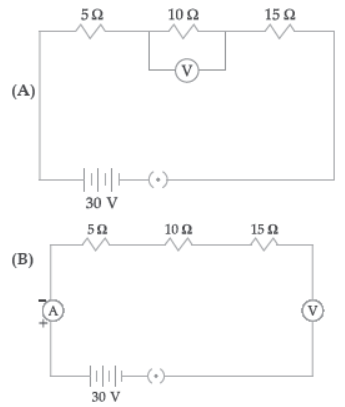
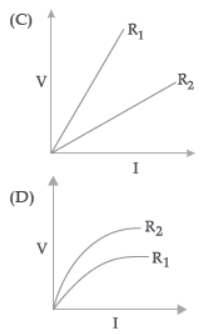
Answer
D
Question. How much is the total resistance in the above circuit diagram?
(a) 30 Ω
(b) 20 Ω
(c) 11/30 Ω
(d) 30/11 Ω
Answer
A
III. Study the given table and answer the questions given below :
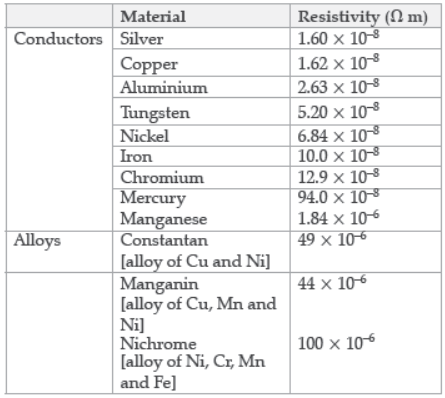
Question. Element used to make filament of incandescent bulb is:
(a) Copper
(b) Silver
(c) Nichrome
(d) Tungsten
Answer
D
Question. What happens to resistance of a conductor when its area of cross section is increased?
(a) Resistance increases
(b) Resistance decreases
(c) No change
(c) Resistance doubles
Answer
B
Question. Which is a better conductor ?
(a) Chromium
(b) Nickel
(c) Mercury
(d) Iron
Answer
B
Question. Element used to make heating element of electric geyser is :
(a) Iron
(b) Silver
(c) Nichrome
(d) Tungsten
Answer
C
IV. Electrical resistivities of some substances, at 20°C are given below in the table. Study the table and answer the given questions.
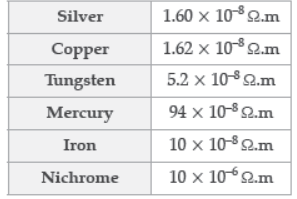
Question. Nichrome is used in the heating elements of electric heating device because:
(a) It has high resistivity
(b) It does not oxidise readily at high temperature
(c) Both of the above
(d) None of the above
Answer
C
Question. Series arrangement is not used for domestic circuits because:
(a) Current drawn is less
(b) Current drawn is more
(c) Neither of the above
(d) Both of the above
Answer
A
Question. Which is a better conductor of electric current ?
(a) Silver
(b) Copper
(c) Tungsten
(d) Mercury
Answer
A
Question. Which element will be used for electrical transmission lines ?
(a) Iron
(b) Copper
(c) Tungsten
(d) mercury
Answer
B
V. Based on the given diagram, answer the questions given below :
In the given circuit, connect a nichrome wire of length ‘L’ between points X and Y and note the ammeter reading.
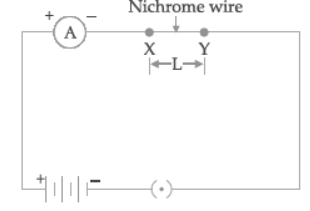
Question. In a circuit two resistors of 5 Ω and 10 Ω are connected in series. Compare the current passing through the two resistors.
(a) 1 : 2
(b) 1 : 3
(c) 2 : 1
(d) 1 : 1
Answer
D
Question. When nichrome and copper wire of same length and same radius are connected in series and current I is passed through them. Which wire gets heated up more?
(a) Nichrome wire
(b) Copper wire
(c) Both will heat up at the same temperature
(d) None of the wire will get heated up.
Answer
A
Question. When this experiment is repeated by inserting another nichrome wire of the same thickness but twice the length (2L), what changes are observed in the ammeter reading ?
(a) Ammeter reading will increase.
(b) Ammeter reading will decrease.
(c) Will show double the increase.
(d) No change in ammeter reading.
Answer
B
Question. State the changes that are observed in the ammeter reading if we double the area of crosssection without changing the length in the above experiment.
(a) Ammeter reading will increase
(b) Ammeter reading will decrease
(c) Will decrease to half
(d) No change in ammeter reading
Answer
A
VI. In the given circuit, three identical bulbs B1, B2 and B3 are connected in parallel with a battery of 4.5 V. Study the diagram and answer the questions given below :
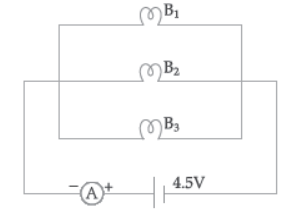
Question. Find the total resistance of the circuit.
(a) 1.0 Ω
(b) 4.5 Ω
(c) 1.5 Ω
(d) 2.0 Ω
Answer
B
Question. How many resistors of 88 W are connected in parallel to carry 10 A current on a 220 V line ?
(a) 2 resistors
(b) 1 resistors
(c) 3 resistors
(d) 4 resistors
Answer
D
Question. What will happen to the other two bulbs if the bulb B3 gets fused ?
(a) They will also stop glowing.
(b) Other bulbs will glow with same brightness.
(c) They will glow with low brightness.
(d) They glow with more brightness.
Answer
B
Question. If the wattage of each bulb is 1.5 W, how much readings will the ammeter A show when all the three bulbs glow simultaneously?
(a) 1.0 A
(b) 2 A
(c) 1.5 A
(d) None of the above
Answer
A
VII. Study the given passage and answer the questions given below:
Two conductors A and B of resistances 5 Ω and 10 Ω respectively are first joined in parallel and then in series. In each case the voltage applied is 20 V.
Question. Which of these circuit diagram shows the correct connection when A and B are joined in parallel?
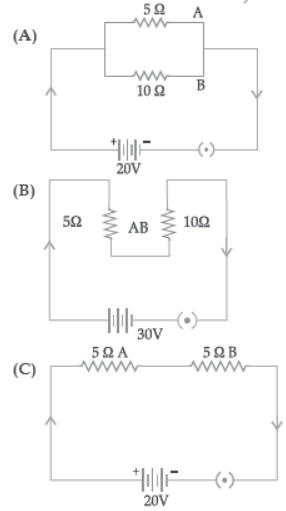
(d) None of these
Answer
A
Question. Equivalent resistance in parallel combination is:
(a) 15 Ω
(b) 3.33 Ω
(c) 0.3 Ω
(d) None of the above
Answer
B
Question. In which combination will the voltage across the conductors A and B be the same ?
(a) Series arrangement
(b) Parallel arrangement
(c) Both of the above
(d) None of the above
Answer
B
Question. In which arrangement will the current through A and B be the same ?
(a) Series arrangement
(b) Parallel arrangement
(c) Both of the above
(d) None of the above
Answer
A
VIII. Study the given circuit diagram and answer the questions given below :
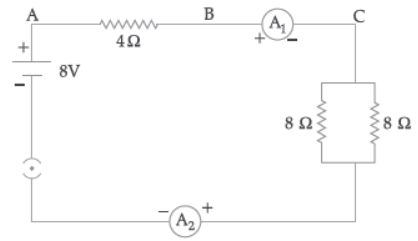
Question. Potential difference across 4 Ω resistor is :
(a) 1V
(b) 2 V
(c) 4 V
(d) 8 V
Answer
C
Question. Power dissipated in 4 Ω resistor is :
(a) 4 W
(b) 2 W
(c) 1 W
(d) 8 W
Answer
A
Question. Effective resistance of two 8 Ω resistors in the combination.
(a) 4 Ω
(b) 16 Ω
(c) 8 Ω
(d) 1 Ω
Answer
A
Question. Current flowing through 4 Ω resistor is :
(a) 1 A
(b) 2 A
(c) 8 A
(d) 4 A
Answer
A
Answer the following questions based on the given circuit.

Question. The current flowing through 6Ω resistor is
(a) 0.50 A
(b) 0.75 A
(c) 0.80 A
(d) 0.25
Answer
D
Question. The current flowing through 0.5Ω resistor is
(a) 1 A
(b) 1.5 A
(c) 3 A
(d) 2.5 A
Answer
A
Question. The total resistance of the circuit is
(a) 2 Ω
(b) 4 Ω
(c) 1.5 Ω
(d) 0.5 Ω
Answer
A
